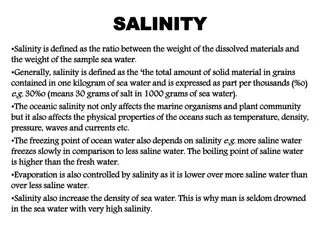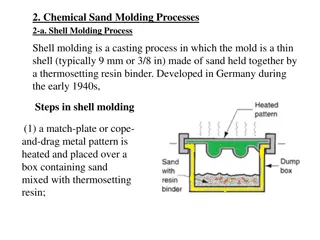Titration Colour Changes
This collection features various experiments in chemistry involving titration and solutions. It includes procedures such as standardizing hydrochloric acid using sodium carbonate, titrating hydrochloric acid with sodium hydroxide to produce sodium chloride, determining the concentration of ethanoic
0 views • 10 slides
ASPEN Staged Separation Unit-Ops
Introduction to Aspen Staged Separation Unit Operations for the purification of desired components by removing impurities and pollutants using distillation, absorption, and stripping columns. This technology is relevant to ammonia synthesis to prevent catalyst poisoning by removing CO2 through absor
0 views • 26 slides
Electrolyte and Metabolic Disturbances in the Critically Ill
Dr. Srilekha Ammapalli discusses the cations (sodium, potassium, calcium, magnesium) and anions (chloride, bicarbonate, phosphate, lactate) involved in electrolyte and metabolic disturbances in critically ill patients. The physiology, causes of abnormalities, diagnosis, evaluation, and management of
2 views • 104 slides
Understanding the Role of Phosphatase Enzymes in Metabolic Reactions
Phosphatase enzymes play a crucial role in various metabolic processes by releasing phosphate groups, increasing their availability for energy synthesis and cell structure formation. Acid phosphatases, with an optimum pH below 7.0, can be extracted from plant tissues like germinating mung beans. A p
7 views • 34 slides
Volumetric Analysis Experiment: Standardization of Hydrochloric Acid Using Sodium Carbonate
In this experiment, hydrochloric acid (HCl) is standardized by using standard sodium carbonate (Na2CO3) due to the impurity of HCl. The process involves preparing 0.1N HCl and Na2CO3 solutions, performing a titration to determine the equivalence point, and calculating the concentration of the HCl so
6 views • 28 slides
Overview of Heavy Chemicals Manufacturing Process
The field of industrial chemistry involves the large-scale preparation of heavy chemicals, which are chemicals produced and used commercially. This process requires an understanding of various physico-chemical principles and specific manufacturing techniques for chemicals like Ammonia, Sulphuric Aci
1 views • 30 slides
Sodium Gluconate Market Business Statistics and Top Overview, Revenue
The most recent Global Sodium Gluconate Market\u00a0Report 2022\u20132029\u00a0from Adroit Market Research offers a thorough analysis of the opportunities, challenges, and trends in this ever-changing industry.
0 views • 5 slides
Global Pharmaceutical Grade Lithium Carbonate Market
The Global Pharmaceutical Grade Lithium Carbonate Market Size is anticipated to exceed USD 175 Million by 2032, growing at a CAGR of 3.1% from 2022 to 2032.\n
0 views • 5 slides
Global Ground Calcium Carbonate Market
\"The Global Ground Calcium Carbonate Market Size is Anticipated to Exceed USD 50.19 Billion by 2033, Growing at a CAGR of 5.94% from 2023 to 2033.\n\"\n
0 views • 5 slides
Global Sodium Cyanide Market
The Global Sodium Cyanide Market Size is Anticipated to Exceed USD 3491.55 Million by 2033, Growing at a CAGR of 4.40% from 2023 to 2033. \n\n
0 views • 5 slides
Understanding Salinity in Seawater and Its Impacts
Salinity is the ratio of dissolved materials to the weight of seawater, affecting marine life and physical ocean properties like temperature, density, and waves. It influences freezing and boiling points, evaporation, and water density. Seawater composition includes salts like sodium chloride, magne
0 views • 11 slides
Efflorescence and Exsiccation in Chemistry
Efflorescence refers to the process where a substance loses water to form a lower hydrate or becomes anhydrous due to differences in vapor pressures. Hydrates with vapor pressures greater than the atmosphere tend to exhibit efflorescence. The rate of efflorescence increases with temperature. Exsicca
0 views • 103 slides
Sodium Triformatoborohydride Formation via NaBH4-CO2 Reaction
Sodium triformatoborohydride, Na[HB(OCHO)3], is synthesized by reacting NaBH4 with CO2 under aprotic conditions. The choice of reductant is crucial for CO2 reduction methods, highlighting the role of NaBH4 as a cost-effective and reactive reducing agent for formate production. The exclusive formatio
1 views • 12 slides
Overview of Veterinary Clinical Pathology and Importance of Anticoagulants
Veterinary clinical pathology involves the laboratory diagnostics and analysis of bodily fluids and tissues to support the diagnosis, treatment, and prevention of diseases. This field encompasses interpreting blood tests, blood smear examinations, and the use of various anticoagulants in specimen co
3 views • 46 slides
Standardisation of Sodium Hydroxide Solution Experiment
The experiment focuses on the standardisation of sodium hydroxide solution using potassium hydrogen phthalate by titration method. It discusses the types of standard solutions, criteria of primary standards, and the difference between standardisation and titration methods. The objective is to determ
1 views • 26 slides
Separating Components of Ternary Mixtures: Experiment and Methods
Experiment aims to separate sand, sodium chloride, and calcium carbonate in a mixture to calculate percentages and recovery. Explore various methods like chromatography, distillation, extraction, centrifugation, crystallization, and sublimation for component separation.
1 views • 30 slides
Sodium Benzoate: Properties, Applications, and Pharmaceutical Uses
Sodium benzoate is a white crystalline powder with various physical and chemical properties. It is commonly used as a preservative in pharmaceutical formulations, cough preparations, and cosmetic products. Additionally, it has pharmaceutical applications in treating urea cycle disorders and schizoph
0 views • 9 slides
Chemical Compounds Overview: Barium, Calcium, Sodium, Lithium
Learn about the uses and potential dangers of Barium Chloride, Barium Carbonate, Barium Sulphate, Calcium Chloride, Calcium Carbonate, Calcium Sulphate, Sodium Chloride, Sodium Carbonate, Sodium Sulphate, Lithium Chloride, Lithium Carbonate, and Lithium Sulphate in various industries and application
0 views • 4 slides
Understanding Bonding in Chemistry
Delve into the world of chemical bonding through ionic, covalent, and metallic bonds. Explore how elements form bonds, from the attraction between sodium and chloride ions to the sharing of electrons in covalent bonds. Witness the formation of compounds like sodium chloride and magnesium oxide, unde
1 views • 12 slides
Understanding Anticoagulants in Laboratory Hematology
Anticoagulants are crucial additives that prevent blood clotting during laboratory procedures. The commonly used anticoagulants include EDTA, sodium citrate, and heparin, each with specific concentrations, modes of action, and color-coded identifications. EDTA is ideal for blood cell counts, sodium
0 views • 6 slides
Understanding Major Intra and Extracellular Electrolytes in Body Fluids
Body fluids contain various electrolytes crucial for maintaining cell and tissue environments. Electrolyte balance is essential for overall health, and external electrolyte replacement therapy may be necessary in certain conditions. The body's fluid compartments - intracellular, interstitial, and pl
0 views • 10 slides
Modeling Water Leak into Sodium in BN-600 Steam Generator
This paper discusses the modeling of a water leak into sodium in the BN-600 steam generator during a specific incident in 1982. It compares calculated data with leak detection system indications and analyzes hydrodynamic parameters in the second sodium circuit. The study utilized SLEAK and LLEAK-3C.
10 views • 9 slides
DIY Erupting Volcano Experiment with Sodium Bicarbonate and Vinegar
Follow these easy steps to create a fun erupting volcano experiment using common household items like sodium bicarbonate and vinegar. Shape the volcano, mix lava ingredients, add vinegar, and watch the eruption happen before your eyes!
0 views • 6 slides
Sodium - Understanding its Role in Your Health
Learn about the importance of sodium in the body, its functions, and the risks of consuming excessive amounts. Discover how sodium impacts health, including its role in maintaining fluid balance and nerve function. Find out ways to reduce salt intake and promote better overall health.
1 views • 38 slides
RCRL Prospective Research Directions in Carbonate Reservoir Characterization
The RCRL group at the University of Texas at Austin specializes in research on carbonate reservoirs at various scales, from nanopores to basin architecture. They focus on developing predictive relationships and tools for reservoir characterization based on subsurface datasets and outcrop analogs. Th
1 views • 12 slides
Exploring Copper Sulfate, Sodium Nitrate, and Ammonium Chloride in Chemistry Projects
Delve into the properties and uses of copper sulfate, sodium nitrate, and ammonium chloride in chemistry projects. Discover how these chemical compounds play vital roles in agriculture, industry, and everyday applications, from fungicides to food additives.
0 views • 9 slides
Exploring Chemical Substances: Dissolved in Water
This article delves into the properties of various chemical substances when dissolved in water, including Calcium Carbonate, Sodium Carbonate, Iron Oxide, Magnesium Sulfate, and Potassium Chloride. It discusses the exothermic and endothermic reactions that occur during dissolution, along with the ch
0 views • 6 slides
Measurement of Oxygen Concentration in Sodium with Plug Indicator FR-22
Determining oxygen concentration in sodium using plug indicators is crucial for experimental facilities and nuclear reactors. This involves lowering sodium temperature slowly until sodium oxide crystallization begins, indicating saturation temperature (TS). Several solubility equations exist for cal
0 views • 6 slides
Understanding the Role of Sodium and Salts in Soil Structure
Soil structure plays a crucial role in plant growth, water movement, and drainage. Excess sodium can cause clay particles to disperse, leading to reduced water infiltration. Flocculation, which involves cations like calcium and magnesium, helps clay particles stick together to form aggregates, impro
0 views • 29 slides
Understanding Soap Making and Uses of Sodium Hydroxide
Soap, an ancient detergent made from fatty acids and alkalis like sodium hydroxide, has been utilized for over 3000 years. Fats and oils are essential raw materials for soap production, and organic acids play a role in creating esters. Sodium hydroxide, a key component in soap making, showcases its
0 views • 9 slides
Stoichiometry Performance Assessment: How Much Baking Soda Do You Need?
The experiment aims to determine the amount of baking soda required to produce a target quantity of sodium carbonate through a thermal decomposition reaction. Students will balance the chemical equation, calculate the necessary NaHCO3 amount, heat the mixture, and compare theoretical versus actual y
0 views • 14 slides
Evaluation of Dynamic Properties and Seismic Performance of Reinforced Ground Using Renewable Materials
Improvement of seismic performance through improved dynamic properties of ground using renewable materials like cement and biopolymer is crucial for reducing earthquake-induced structural damage. This study conducted resonant column tests to assess the enhanced dynamic properties of soil and utilize
0 views • 9 slides
Overview of Shell and Sodium Silicate Molding Processes in Casting
Shell molding is a casting process involving a thin sand shell held together by a resin binder, offering advantages like smoother mold cavity surfaces and good dimensional accuracy. However, it can be costly for small quantities. Sodium Silicate Molding Process involves coating refractory materials
0 views • 19 slides
Understanding Adulterants, Preservatives, and Neutralizers in Milk and Milk Products
Adulteration in milk involves adding cheaper substances or removing valuable constituents to make extra profit. Common adulterants include carbohydrates, salts, neutralizers, preservatives, detergents, and oils. Preservatives like hydrogen peroxide and formalin are used to prolong shelf life. Neutra
0 views • 13 slides
Laboratory Preparation of Nitric(V) Acid & Chemical Reactions
In this set of questions, we explore the preparation of nitric(V) acid in a school laboratory setting, its properties, and chemical reactions. Topics covered include the use of sodium nitrate(V) and potassium nitrate(V), the use of glass apparatus during the preparation process, color changes in con
0 views • 4 slides
Detecting Cobalt(II) Ion Reactions in Solutions
This experiment outlines various methods for detecting Cobalt(II) ions (Co2+) in solution using reagents like sodium hydroxide, ammonia, sodium or potassium carbonate, and more. Observations and changes in color are noted throughout the process to identify the presence of the Cobalt ions. The reacti
0 views • 19 slides
Preparation of Calcium Peroxide (CaO2) in Inorganic Chemistry Practical II
This practical experiment details the preparation of calcium peroxide, a solid peroxide used in various industries and agriculture. The procedure involves the reaction of calcium salt and sodium peroxide to synthesize calcium peroxide, which has applications in agriculture, aquaculture, ecological r
0 views • 7 slides
Understanding Endothermic and Exothermic Reactions Through Experiment
Explore the concepts of endothermic and exothermic reactions with a detailed experiment to determine which solute dissolves most endothermically and exothermically in water. Discover the roles of heat transfer in chemical reactions using potassium chloride, calcium chloride, sodium carbonate, and so
0 views • 11 slides
Understanding Buffers in Pharmaceutical Formulations
Buffers in pharmacy play a critical role in maintaining constant pH levels essential for drug stability and efficacy. They resist pH changes by neutralizing added acids or bases, ensuring proper drug delivery and patient comfort. Common buffer systems, such as acetic acid/sodium acetate and boric ac
4 views • 18 slides







































